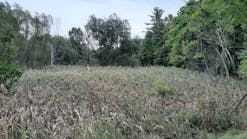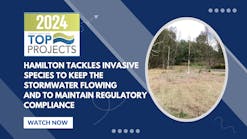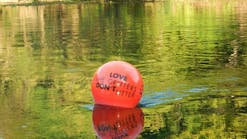Retaining Wall Designs Showcase Multiple Site Considerations
In Part 1 of a series, which examines retaining wall design as well as aesthetic site-based considerations, author Carol Brzozowski elaborates upon two examples from a larger feature of multiple project sites. In each part, Brzozowski will cover retaining wall construction elements and post-completion objectives. For example, project designers and general contractors certainly might create and implement a retaining wall system that incorporates slope stability and sound erosion control methods as well as functionality for the sites’ intended user-groups.
A Gamut of Retaining Walls (Part 1) By Carol Brzozowski
These days, retaining walls are not only doing the job of keeping water and soil at bay and shoring up slopes and hillsides, but also are providing aesthetic value while doing so. Erosion control specialists throughout North America are choosing walls that serve multiple purposes and can be installed quickly.
Round Lake
In Eden Prairie, MN, city officials decided to make some improvements to the park at Round Lake. A main feature to be added was a “splash pad,” which would incorporate a number of spray features, as well as playground equipment for toddlers and teens.
The design called for shaded seating around and overlooking the play areas. A ReCon Retaining Walls system was selected to create the grade separation between the area with the splash pad and playground equipment and the viewing area.
The machine-set ReCon block is made of wet-cast concrete and is especially chosen for areas exposed to road salts, brackish water, and freeze/thaw cycles. It is also used in tall gravity retaining walls where the wall is being built as a cut into the side of an existing embankment.
The product also offers such natural stone textures as granite, limestone, rustic, weathered-edge, and “Old World” choices.
The retaining wall design of the Round Lake Park was completed by Jason Amberg, a landscape architect with WSB Engineering in Minneapolis, MN. He has used ReCon blocks on three different playgrounds in the Twin Cities area, favoring it for how it fits in with playground equipment. The blocks were sourced from Cretex Concrete Products in Maple Grove, MN.
Some 3,800 square feet of ReCon block was used for the Eden Prairie project, which featured walls with curves transitioning to corners and then returning to more smooth curves. Freestanding walls also were incorporated into the design.
Durability also was a factor in the project, as the ReCon block would be tread upon, sat upon, and regularly sprayed with water from the splash pad.
Jim Janson, owner of Oddesa II, a landscape and hardscape firm in Sauk Rapids, MN, constructed the walls during July and August 2012. “It’s a good block to work with, easy to install,” he says. “On the corners, there are a lot of radiuses that stay tight. There can be a lot of challenges when doing corners.”
Wildlife Crossing
After project construction began in 2012 on a wildlife overcrossing on Interstate 80 in Elko County, NV, a biochemical complication arose: The fill source available in the area is hot soil that is highly corrosive.
The contractor, Fisher Sand & Gravel, had planned to use a steel reinforcement element, which would have reacted quickly to the soil components and compromised the integrity of the structure.
Fisher Sand & Gravel approached Tensar International in December 2012 for the DOT wall project, which had gone through the retaining wall design process with another mechanically stabilized earth (MSE) wall supplier.
“Getting close to the production and construction phases, they realized they were some challenging soils-what we call hot soils or aggressive soils-which are corrosive to steel elements,” says Matt Doss, a grade separation solutions regional manager for Tensar. “It was becoming very cost prohibitive for them to find backfill for this MSE wall within a reasonable distance that would work for the metallic reinforcing that the originally intended MSE wall used.”
The contractor solved the problem by installing 14,000 square feet of Tensar International’s HDPE ARES Retaining Wall System, a reinforcing product that is designed to resist chemical, biological, or electrical corrosion. The ARES system used in this application consisted of 5-foot by 9-foot panels.
The ARES systems feature integrated components developed to work together for optimum efficiency, performance, and ease of installation. Those components include precast panel facings with compressive strength that meets AASHTO standards. The panel facings are available in standard or customized dimensions. Bodkin connectors are designed to secure Tensar geogrids to the panels. The panel-to-geogrid positive mechanical connection is designed to ensure full load transfer from wall face to reinforcement for reliability even in settlement-prone areas.
With the system being made of high-density polyethylene (HDPE) material, soil reinforcement is 100% synthetic, eliminating concerns about corrosion from long-term exposure to chlorides, sulfates, low-resistivity soils, or random electrical currents.
The system also allows for the use of a range of backfills, including recycled materials, for cost savings and sustainable design.
Continuing construction with Tensar products allowed Fisher Sand & Gravel to complete the project “with exactly the desired aesthetic, dimensions, and loadings, while increasing the safety for drivers,” notes Doss, adding that the client also got a “long design life” for the MSE wall.





